USB-C audio interfaces are becoming increasingly popular, as they offer a number of advantages over traditional USB-A interfaces. USB-C connectors are reversible, which makes them easier to plug in, and they also support faster data transfer speeds. This makes USB-C audio interfaces ideal for high-resolution audio recording and playback.
When choosing a USB-C audio interface, there are a few key factors to consider:
- Audio Resolution: The audio resolution is the quality of the audio that the interface can record and playback. Higher audio resolutions produce better sound quality, but they also require more processing power from your computer. A good audio resolution for most applications is 24-bit/96kHz.
- Gain Control Range: The gain control range is the amount of amplification that the interface can provide. A high gain control range is important if you are recording quiet sources, such as vocals or acoustic guitars.
- Audio Quality: The audio quality of the interface is determined by a number of factors, including the converters, preamps, and output stage. Look for an interface that uses high-quality components and has a good reputation for sound quality.
This article will delve into the world of USB-C audio interfaces, exploring their benefits, the “key factors to consider” when choosing one, and the top options available in 2023.
Outline
ToggleBest USB-C Audio Interface Table
| Best USB-C Audio Interface | Audio Resolution | Gain Control Range | Buy Now |
|---|---|---|---|
| Focusrite USB-C Audio Interface | 24-bit/192kHz | 70 dB | Check On Amazon |
| M-Audio USB-C Audio Interface | 24-bit/192kHz | 55 dB | Check On Amazon |
| Universal Audio USB-C Audio Interface | 24-bit/192kHz | - | Check On Amazon |
| MOTU USB-C Audio Interface | 96 kHz | - | Check On Amazon |
| Arturia USB-C Audio Interface | 24-bit/192kHz | 56 dB | Check On Amazon |
| PreSonus USB-C Audio Interface | 24-bit/192kHz | 50 dB | Check On Amazon |
| Rode USB-C Audio Interface | 24-bit/192kHz | 60 dB | Check On Amazon |
Best USB-C Audio Interface Reviews
1. Focusrite USB-C Audio Interface

Best Features:
- Studio-quality sound at an affordable price.
- Easy to use, even if you’re new to recording.
- Comes with all the software and tools you need to get started.
- Backed by Focusrite’s three-year warranty.
Pros:
- Compact and portable.
- Comes with all the software and tools you need to get started.
Cons:
- Only has one mic input and one instrument input.
2. M-Audio USB-C Audio Interface
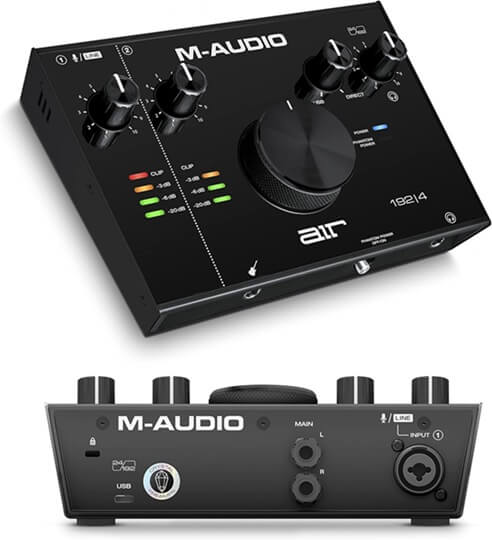
Best Features:
- Premium components and pristine sound.
- Intuitive design and easy operation.
- Extensive software bundle.
- USB-C ready.
- Zero-latency monitoring.
- Rugged construction.
Pros:
- Comes with a comprehensive software bundle.
- Versatile and can be used for a variety of applications.
Cons:
- Some issues with windows10.
3. Universal Audio USB-C Audio Interface
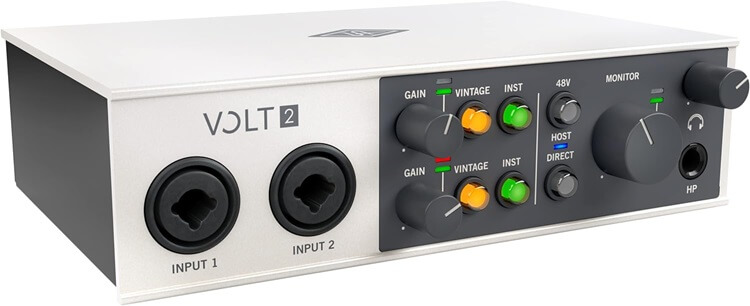
Best Features:
- Superior studio sound quality, with more character and tone than any USB interface in its class.
- Exclusive Vintage Mic Preamp mode for rich, full sound.
- Curated suite of industry-leading audio software included.
- USB bus powered for on-the-go recording.
- Studio-quality headphone amp and MIDI connections.
- 30-day free trial subscription to UAD Spark.
Pros:
- Portable and lightweight.
- Comes with a variety of useful software.
Cons:
- Some issues with 3rd party software.
4. MOTU USB-C Audio Interface
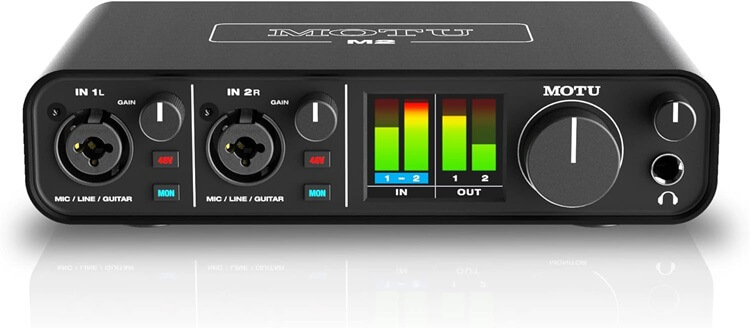
Best Features:
- Sabre32 Ultra DAC technology for pristine audio clarity.
- Best-in-class speed for ultra-low latency monitoring.
- Best metering for precise level control.
- Live streaming loopback for easy streaming and podcasting.
- A tradition of engineering excellence.
Pros:
- Professional-level metering.
- Versatile features.
Cons:
- Some driver issues.
5. Arturia USB-C Audio Interface

It’s touted for its sound quality, with a 110dB dynamic range and an impressive equivalent input noise level. Additionally, the MiniFuse 1 comes with a bundle of software, including Ableton Live Lite, Analog Lab Intro, Arturia FX, NI GUITAR RIG 6 LE, Auto-Tune Unlimited, and Splice Creator Plan, facilitating music production. If you’re in search of a portable solo audio interface that offers simplicity and included software, the Arturia MiniFuse 1 may be an option to consider.
Best Features:
- Compact and lightweight design.
- World-class sound quality.
- Included software suite.
- 5-year warranty.
Pros:
- Comprehensive software bundle.
- Great customer support.
Cons:
- Unstable software in macOS.
6. PreSonus USB-C Audio Interface
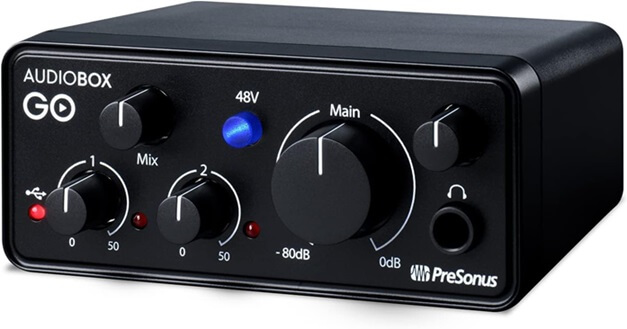
One of its conveniences is bus-powered operation, making it portable without the need for an external power source. It’s compatible with various devices, including Apple, Android, laptops, and desktop computers. It also comes with Studio One Prime recording software and the Studio Magic software bundle, equipping you with the necessary tools to start recording and producing music right away. If you’re in search of a budget-friendly, compact audio interface for on-the-go recordings, the PreSonus AudioBox GO is a practical choice.
Best Features:
- Ultra-portable and compact.
- Bus-powered.
- Studio-grade converters.
- Custom XMAX-L mic preamp.
- 1 TS instrument input and 1 XLR mic/line combo input.
- 1 TRS 1/4” stereo headphone output.
- 2 balanced TRS 1/4” main outputs.
Pros:
- Compatible with a wide range of devices and software.
- Includes Studio One Prime and Studio Magic software.
Cons:
- It is not compatible with all instruments.
7. Rode USB-C Audio Interface
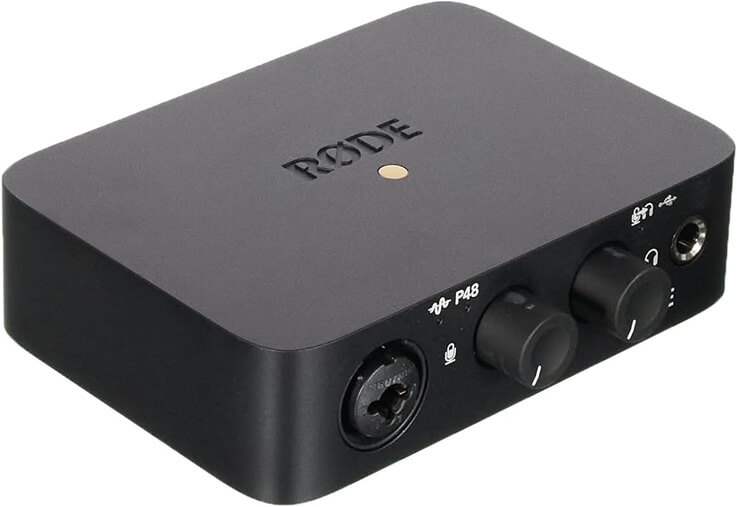
Best Features:
- Studio-grade preamp for pristine audio capture.
- High-power headphone amp for confident monitoring.
- 60dB of gain to handle even the lowest output mics.
- USB bus-powered for portability.
- Compatible with Mac and Windows.
Pros:
- Versatile and easy to use.
- Portable and convenient.
Cons:
- Only one channel.
Also Check: Best 4-Channel Audio Interfaces
Buying Guide for Best USB-C Audio Interface
1. Audio Resolution
As mentioned above, audio resolution is the quality of the audio that your interface can record and playback. It’s measured in bits and hertz. Bits refer to the number of different levels that the audio signal can be digitized into. Hertz refers to the number of times the audio signal is sampled per second.
For most home and project studio applications, 24-bit/192kHz audio resolution is more than enough. However, if you’re planning on recording or mastering audio for professional release, you may want to consider an interface with a higher audio resolution.
2. Gain Control Range
Gain control range refers to the amount of amplification that your interface’s preamps can provide. This is important because different microphones and instruments require different amounts of gain.
If you’re recording a quiet microphone, you’ll need an interface with a preamp that has a high gain range. This will allow you to boost the signal to a level that can be recorded properly.
3. Audio Quality
The audio quality of your interface will depend on a number of factors, including the quality of the preamps, converters, and clocking.
Preamps are responsible for amplifying the signal from your microphone or instrument. Converters are responsible for converting the analog signal from your microphone or instrument to a digital signal that can be recorded by your computer. Clocking is responsible for ensuring that the digital signal is synchronized with your computer’s clock.
If you’re serious about audio production, you’ll want to choose an interface with high-quality preamps, converters, and clocking.
4. Drivers
Drivers are software programs that allow your computer to communicate with your audio interface. It’s important to make sure that your interface comes with drivers that are compatible with your operating system.
Most USB-C audio interfaces come with drivers for both Windows and Mac operating systems. However, it’s always a good idea to check the manufacturer’s website before you buy to make sure that the drivers are compatible with your specific setup.
5. Connectivity
In addition to USB-C, many audio interfaces also offer other connectivity options, such as MIDI I/O, SPDIF, and ADAT.
If you need to connect MIDI devices, such as a keyboard or drum machine, to your computer, you’ll need an interface with MIDI I/O ports.
If you want to record digital audio from another device, such as a digital mixer or CD recorder, you’ll need an interface with a SPDIF or ADAT input.
6. Inputs/Output Ports
The number of inputs and outputs that your interface needs will depend on your specific needs. If you’re just starting out, a two-input, two-output interface should be sufficient. But if you plan on recording multiple musicians or instruments at the same time, you’ll need an interface with more inputs.
In addition to XLR/TRS inputs for microphones and instruments, many audio interfaces also offer line inputs and outputs. Line inputs are used to connect devices such as synthesizers and drum machines. Line outputs are used to connect your interface to speakers or headphones.
USB-C Audio Interface – FAQs
Ans: Most USB-C audio interfaces are compatible with both Mac and Windows. Always check the product specifications to ensure compatibility with your specific system.
Ans: Yes, many USB-C audio interfaces are compatible with iOS devices and Android tablets. However, make sure to check the manufacturer’s compatibility list.
Ans: The choice depends on your specific needs. Budget options like the PreSonus AudioBox USB 96 can deliver good results for home recording, while high-end interfaces offer superior sound quality and features.
Ans: USB-C offers faster data transfer and is becoming a universal standard for various devices. Thunderbolt interfaces provide even higher speeds but may require specific ports on your computer.
Ans: To optimize your interface for live performances, ensure low latency and reliable connections. Use a stable USB-C cable and configure your software for real-time monitoring.
Conclusion
When choosing a USB-C audio interface, there are a few factors to consider, such as the number of inputs and outputs you need, the type of audio you’ll be recording, and your budget.
-
- If you’re a beginner or budget-minded musician, the PreSonus USB-C Audio Interface is a good option.
- If you need more inputs and outputs, or if you want to take advantage of UAD plug-ins, the M-Audio USB-C Audio Interface is a good choice.
- And if you’re looking for a portable and affordable USB-C audio interface, the MOTU USB-C Audio Interface is a great option.
No matter what your needs are, there’s a USB-C audio interface out there that’s perfect for you.

